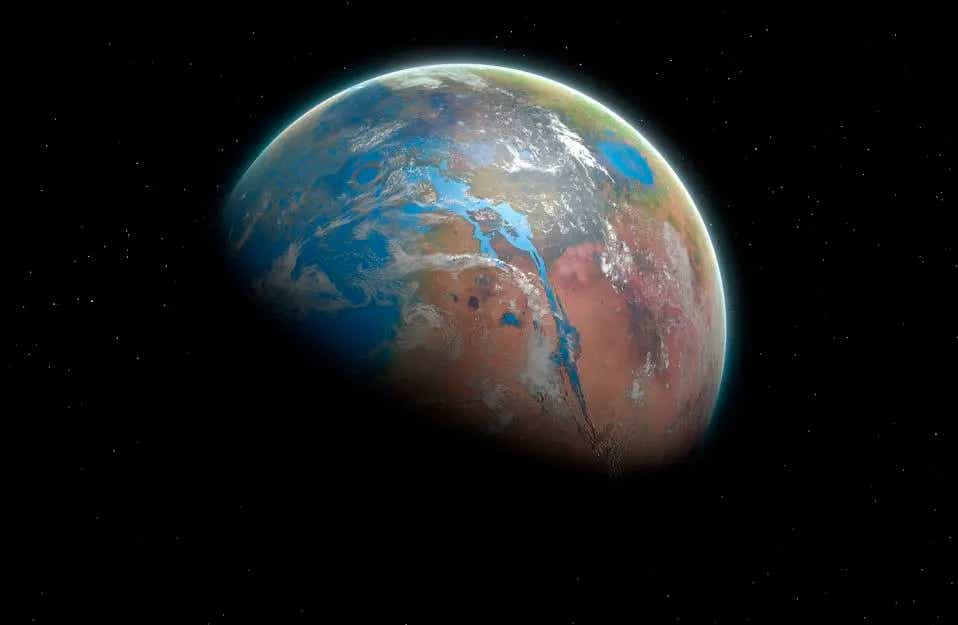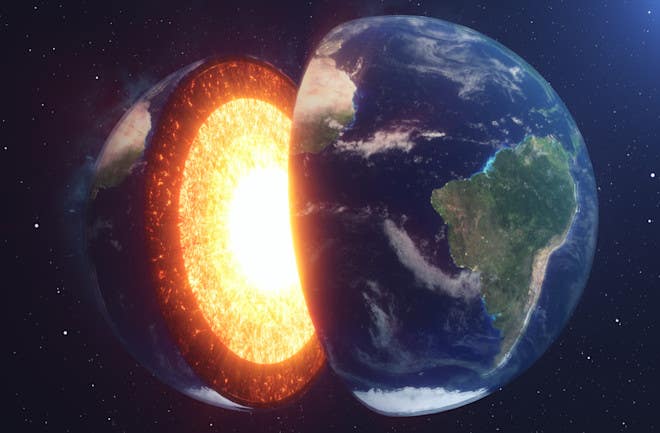Massive Martian ice deposit could flood entire planet under 9 feet of water
New radar data reveals a 2.2-mile-deep ice deposit under Mars’ equator that could cover the planet in nine feet of water.

Beneath Mars’ equator, radar scans reveal a buried ice deposit that could flood the entire planet in water nearly nine feet deep. (CREDIT: Getty Images)
Mars may look like a dry and dusty world, but just beneath its surface lies one of the most surprising discoveries in planetary science. Stretching for hundreds of miles along the planet’s equator is the Medusae Fossae Formation, or MFF—a mysterious landscape of wind-shaped ridges and soft, eroded hills. While it may seem like another dusty region of Mars, fresh data from a deep-penetrating radar system tells a very different story.
This giant deposit might be hiding a frozen ocean under layers of ancient Martian dust. If that ice melted, scientists say, it could flood the entire surface of Mars in water nearly nine feet deep. That’s more water than Earth’s Red Sea holds, buried under one of the most debated and puzzling formations on the Red Planet.
A landmark discovery beneath the Martian surface
For years, researchers have studied MFF without knowing exactly what it was made of. Some thought it was a huge pile of volcanic ash. Others said it could be ancient dust carried by wind, or sediment left behind by a long-gone sea. But a radar instrument aboard the European Space Agency’s Mars Express spacecraft has revealed new clues.
Known as MARSIS—the Mars Advanced Radar for Subsurface and Ionospheric Sounding—the radar system bounces radio waves into the ground and measures the echoes that come back. These echoes can reveal structures hidden deep underground.
Using updated MARSIS data, scientists now believe that the MFF is far thicker than earlier thought—reaching depths of up to 2.2 miles (3.7 kilometers). “We’ve explored the MFF again using newer data from Mars Express’s MARSIS radar and found the deposits to be even thicker than we thought,” says Thomas Watters of the Smithsonian Institution, lead author of the study. “Excitingly, the radar signals match what we’d expect from layered ice, similar to Mars’ known polar ice caps.”
Ice, not dust: Modeling reveals what lies below
The radar reflections show strong, wide underground layers that stretch for hundreds of miles. These signals suggest that the material underground suddenly changes in density, which only happens if the layers are made from different things—like dust and ice.
If the MFF were just a massive pile of dry material like dust or volcanic ash, gravity would have compacted it over time. But modeling shows that these types of dry material can’t explain what the radar sees. “Here’s where the new radar data comes in! Given how deep it is, if the MFF was simply a giant pile of dust, we’d expect it to become compacted under its own weight,” says Andrea Cicchetti of Italy’s National Institute for Astrophysics.
Related Stories
“This would create something far denser than what we actually see with MARSIS,” Cicchetti adds. “And when we modeled how different ice-free materials would behave, nothing reproduced the properties of the MFF—we need ice.”
This conclusion is supported by earlier radar observations, which showed the MFF to be both low in density and mostly transparent to radar waves. Scientists believe these are signatures of layered ice buried beneath a protective blanket of dust or ash. This insulating layer, which may be 1,000 feet (300 meters) thick, helps preserve the ice from Mars' dry, freezing environment.
The size of a sea, hidden in plain sight
What makes the discovery even more dramatic is just how much water may be stored here. If all the ice in the MFF melted, it would create a global ocean between 5 and 9 feet (1.5 to 2.7 meters) deep. That’s more than any known water deposit near the Martian equator and rivals the volume of Earth’s Red Sea.
And this ice isn't hiding in the poles—it lies near the Martian equator, where future human missions are most likely to land. The planet’s poles, while rich in ice, are challenging for landers due to their steep slopes and extreme temperatures. In contrast, the MFF region could offer easier access to this essential resource.
“This latest analysis challenges our understanding of the Medusae Fossae Formation and raises as many questions as answers,” says Colin Wilson, a project scientist for the European Space Agency’s Mars Express and ExoMars Trace Gas Orbiter. “How long ago did these ice deposits form, and what was Mars like at that time?”
These questions aren’t just about water—they’re about history. A frozen layer beneath the equator points to a time when Mars may have had a very different climate, possibly with flowing water, rainfall, or even shallow seas.
A frozen key to Mars’ past—and future
The idea that Mars once held more water isn’t new. Scientists have long seen signs of rivers, lakebeds, and ancient ocean basins. But the MFF’s equatorial ice adds a new piece to the puzzle, suggesting that the planet’s climate allowed water to freeze even far from the poles.
Understanding this climate shift is important not only for science but also for exploration. If astronauts ever land near the equator, ice could supply drinking water, oxygen, and even fuel—essential for long missions and return trips to Earth.
Still, access to the MFF’s frozen reservoir won’t be easy. “The MFF deposits, buried under extensive dust layers, remain out of reach for the time being,” says Wilson. “Yet, each discovery of Martian ice enriches our understanding of the planet’s hydrological history and current water distribution.”
Radar readings from MARSIS support this, but another spacecraft is helping too. The ExoMars Trace Gas Orbiter, also operated by ESA, carries an instrument called FREND that detects hydrogen near the surface. In recent years, FREND spotted a hydrogen-rich zone in Valles Marineris, a deep canyon system the size of the United States. Together, these orbiters are revealing how widespread water may be on modern Mars.
Could future explorers tap the MFF?
While digging into the MFF remains a challenge, its value is clear. The combination of radar data, modeling, and Martian geology points to a massive ice sheet hidden beneath wind-carved dust. This suggests the region has been stable for a very long time, possibly preserving clues to ancient life or environmental conditions.
The idea that pumice rafts from an ancient Martian sea may have drifted to this region and settled into massive deposits, as one theory suggests, is still being debated. But what is now clear is that the MFF holds far more than just dust—it may be the most important water reservoir near Mars’ equator.
“This discovery opens up new opportunities for exploration and forces us to rethink what we know about Mars,” says Wilson. “Any reservoir of ancient water would be a fascinating target for human or robotic exploration.”
The Red Planet continues to surprise
In the end, the Medusae Fossae Formation represents more than just a strange region on Mars. It holds secrets about the planet’s past climate, its potential for life, and its future as a place where humans might live.
Layer by layer, Mars is revealing its hidden history. And in the case of the MFF, that history includes a frozen ocean, buried in dust, waiting to be understood.
Research findings were published in the journal Geophysical Research Letters.
Note: The article above provided above by The Brighter Side of News.
Like these kind of feel good stories? Get The Brighter Side of News' newsletter.
Joseph Shavit
Head Science News Writer | Communicating Innovation & Discovery
Based in Los Angeles, Joseph Shavit is an accomplished science journalist, head science news writer and co-founder at The Brighter Side of News, where he translates cutting-edge discoveries into compelling stories for a broad audience. With a strong background spanning science, business, product management, media leadership, and entrepreneurship, Joseph brings a unique perspective to science communication. His expertise allows him to uncover the intersection of technological advancements and market potential, shedding light on how groundbreaking research evolves into transformative products and industries.



